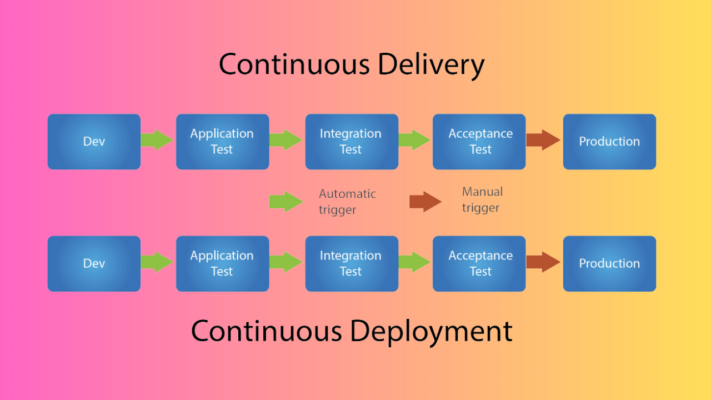
In the fast-paced world of software development, delivering high-quality products quickly and efficiently is critical to staying competitive. Two key practices that have emerged to help teams achieve this goal are Continuous Delivery and Continuous Deployment. While these terms are often used interchangeably, they actually represent distinct approaches to software delivery.
In this comprehensive guide, we’ll explore the differences between Continuous Delivery vs Continuous Deployment, their benefits and challenges, and how they fit into the broader context of DevOps and digital transformation trends. We’ll also draw on insights from industry leaders and real-world examples to help you determine which approach is right for your organization.
Whether you’re a software developer, IT manager, or business leader, understanding the nuances of Continuous Delivery vs Continuous Deployment is essential to driving innovation, improving quality, and accelerating time-to-market. So let’s dive in and explore these practices in depth.
What is Continuous Delivery?
Continuous Delivery is a software development practice that aims to automate and streamline the process of delivering software changes to production. The goal of Continuous Delivery is to ensure that every change that passes the automated tests can be deployed to production quickly and safely.
In a Continuous Delivery pipeline, every code change is automatically built, tested, and packaged for release. However, the final decision to deploy to production is made manually by a human operator. This allows for additional testing, validation, and approval before releasing changes to end-users.
The key principles of Continuous Delivery include:
1. Automate everything: Build, test, and deployment processes should be fully automated to reduce manual errors and increase efficiency.
2. Build quality in: Automated tests and quality checks should be integrated throughout the development process to catch issues early and ensure high-quality code.
3. Work in small batches: Changes should be small, incremental, and frequent to reduce risk and enable faster feedback loops.
4. Continuous improvement: The delivery process should be continuously monitored, measured, and optimized to identify bottlenecks and improve performance.
Benefits of Continuous Delivery
Implementing Continuous Delivery can bring numerous benefits to software development teams and organizations, including:
1. Faster time-to-market: By automating the delivery process and enabling more frequent releases, teams can deliver new features and updates to customers faster.
2. Higher quality: Automated testing and quality checks throughout the development process help catch issues early and ensure that only high-quality code is delivered to production.
3. Lower risk: Small, incremental changes are less risky than large, infrequent releases, reducing the potential impact of any issues that may arise.
4. Improved collaboration: Continuous Delivery encourages collaboration between development, testing, and operations teams, breaking down silos and fostering a culture of shared responsibility.
5. Increased efficiency: Automating manual tasks and streamlining the delivery process frees up time and resources for more value-added activities, such as innovation and experimentation.
Challenges of Continuous Delivery
While the benefits of Continuous Delivery are significant, implementing this practice also comes with its own set of challenges, including:
1. Cultural change: Adopting Continuous Delivery requires a significant shift in mindset and culture, from siloed teams and manual processes to a collaborative, automated approach.
2. Technical complexity: Building and maintaining a fully automated delivery pipeline can be complex and time-consuming, requiring specialized skills and tools.
3. Legacy systems: Integrating legacy systems and applications into a Continuous Delivery pipeline can be challenging, requiring significant refactoring and modernization efforts.
4. Compliance and regulatory requirements: Ensuring compliance with industry regulations and security standards can be more challenging in a Continuous Delivery environment, requiring additional controls and auditing.
What is Continuous Deployment?
Continuous Deployment takes the principles of Continuous Delivery one step further by automatically deploying every change that passes the automated tests directly to production, without any manual intervention.
In a Continuous Deployment pipeline, every code change that passes the automated tests is automatically released to end-users, without any additional testing, validation, or approval. This requires a high degree of confidence in the automated tests and the overall quality of the code.
The key principles of Continuous Deployment include:
1. Fully automated pipeline: The entire delivery process, from code commit to production deployment, should be fully automated, with no manual steps or approvals.
2. Continuous testing: Automated tests should be comprehensive and reliable, covering all critical functionality and edge cases.
3. Rapid feedback: Any issues or failures should be quickly detected and resolved, with automated rollbacks and alerts in place to minimize the impact on end-users.
4. Incremental releases: Changes should be small, frequent, and incremental to reduce risk and enable faster iterations and experimentation.
Benefits of Continuous Deployment
Implementing Continuous Deployment can bring additional benefits beyond those of Continuous Delivery, including:
1. Faster feedback loops: By releasing changes to end-users immediately, teams can gather feedback and data more quickly, enabling faster iterations and improvements.
2. Increased experimentation: Continuous Deployment enables teams to rapidly test new ideas and features with real users, fostering a culture of innovation and experimentation.
3. Reduced risk: Automated testing and incremental releases reduce the risk of large, disruptive failures, enabling teams to quickly detect and resolve issues.
4. Improved efficiency: Fully automating the delivery process eliminates manual bottlenecks and delays, enabling teams to deliver value to customers more efficiently.
Challenges of Continuous Deployment
While Continuous Deployment can bring significant benefits, it also comes with its own set of challenges, including:
1. High-quality automated tests: Continuous Deployment requires a high degree of confidence in the automated tests, which must be comprehensive, reliable, and maintainable.
2. Monitoring and alerting: With changes being released to production automatically, robust monitoring and alerting systems must be in place to quickly detect and resolve any issues.
3. Culture of experimentation: Continuous Deployment requires a culture that embraces experimentation and is willing to accept occasional failures as part of the learning process.
4. Compliance and regulatory requirements: Ensuring compliance with industry regulations and security standards can be more challenging in a Continuous Deployment environment, requiring additional controls and auditing.
Continuous Delivery vs Continuous Deployment: Key Differences
While Continuous Delivery and Continuous Deployment share many similarities, there are some key differences between these two practices:
1. Manual vs. automated deployment: Continuous Delivery involves a manual decision to deploy changes to production, while Continuous Deployment automatically deploys every change that passes the automated tests.
2. Risk and control: Continuous Delivery provides more control and risk management, with the option to manually review and approve changes before deployment. Continuous Deployment requires a higher level of confidence in the automated tests and the overall quality of the code.
3. Speed and frequency of releases: Continuous Deployment enables faster and more frequent releases than Continuous Delivery, as changes are automatically deployed as soon as they pass the automated tests.
4. Cultural and organizational impact: Continuous Deployment requires a more significant cultural and organizational shift than Continuous Delivery, with a greater emphasis on experimentation, rapid feedback, and accepting occasional failures.
Industry Insights and Best Practices
To gain a deeper understanding of Continuous Delivery vs Continuous Deployment, let’s explore some insights and best practices from industry leaders and experts.
1. “Continuous Delivery is about delivering value to customers frequently and reliably, while Continuous Deployment is about automating the entire deployment process. Both practices require a high degree of automation, collaboration, and quality, but Continuous Deployment takes it to the next level.” – Jez Humble, co-author of “Continuous Delivery” and “Lean Enterprise”
2. “Implementing Continuous Delivery or Continuous Deployment is not just a technical challenge, but also a cultural one. It requires breaking down silos, fostering collaboration, and embracing a culture of experimentation and learning.” – Nicole Forsgren, co-author of “Accelerate: The Science of Lean Software and DevOps”
3. “The key to successful Continuous Delivery and Continuous Deployment is to start small and iterate. Focus on automating the most critical and frequently used processes first, and gradually expand your automation coverage over time.” – Gene Kim, co-author of “The Phoenix Project” and “The DevOps Handbook”
4. “Continuous Delivery and Continuous Deployment are not one-size-fits-all practices. The right approach depends on your organization’s goals, culture, and risk tolerance. It’s important to carefully evaluate your options and choose the approach that aligns best with your needs and constraints.” – Mirco Hering, author of “DevOps for the Modern Enterprise”
Real-World Examples
Let’s take a look at some real-world examples of organizations that have successfully implemented Continuous Delivery or Continuous Deployment:
1. Netflix: Netflix is known for its highly automated and resilient Continuous Deployment pipeline, which enables the company to release thousands of changes per day with minimal disruption to customers.
2. Etsy: Etsy has implemented a Continuous Deployment approach that allows the company to release changes to production up to 50 times per day, while maintaining high levels of quality and reliability.
3. Amazon: Amazon has a well-established Continuous Delivery pipeline that enables the company to deliver new features and updates to customers quickly and safely, with the option to manually review and approve changes before deployment.
4. Airbnb: Airbnb has implemented a Continuous Delivery approach that allows the company to deliver new features and updates to customers on a weekly basis, while maintaining high levels of quality and reliability.
Continuous Delivery vs Continuous Deployment in the Context of Digital Transformation
Continuous Delivery and Continuous Deployment are not just technical practices, but also key enablers of digital transformation. As organizations seek to become more agile, responsive, and customer-centric, adopting these practices can help accelerate innovation, reduce time-to-market, and improve the overall customer experience.
According to a recent survey by Gartner, 91% of organizations are engaged in some form of digital transformation, with a focus on improving customer experience, increasing efficiency, and driving new revenue streams. Continuous Delivery and Continuous Deployment can play a critical role in supporting these digital transformation trends and initiatives.
For example, by enabling faster and more frequent releases, Continuous Delivery and Continuous Deployment can help organizations respond more quickly to changing customer needs and preferences. By automating manual tasks and streamlining the delivery process, these practices can also help increase efficiency and reduce costs, freeing up resources for more value-added activities.
Furthermore, Continuous Delivery and Continuous Deployment can help organizations build a culture of experimentation and innovation, by enabling teams to rapidly test new ideas and features with real users. This can help drive new revenue streams and business models, as well as improve the overall customer experience.
Conclusion
In today’s fast-paced and highly competitive business environment, delivering high-quality software quickly and efficiently is more important than ever. Continuous Delivery and Continuous Deployment are two key practices that can help organizations achieve this goal, by automating and streamlining the software delivery process.
While Continuous Delivery and Continuous Deployment share many similarities, they also have some key differences in terms of risk, control, speed, and cultural impact. The right approach depends on your organization’s goals, culture, and risk tolerance, and requires careful evaluation and planning.
Regardless of which approach you choose, implementing Continuous Delivery or Continuous Deployment is not just a technical challenge, but also a cultural and organizational one. It requires breaking down silos, fostering collaboration, and embracing a culture of experimentation and learning.
As you embark on your own journey towards Continuous Delivery or Continuous Deployment, it’s important to work with experienced partners who can guide you through the process and help you navigate the challenges and opportunities along the way.
That’s where Upcore Technologies comes in. As a leading provider of digital transformation services and product development services, Upcore Technologies has deep expertise in Continuous Delivery, Continuous Deployment, and all stages of new product development. Whether you’re looking to modernize your existing applications, build new digital products and services, or optimize your software delivery processes, Upcore Technologies can help you achieve your goals and stay ahead of the curve.
So if you’re ready to take your software delivery to the next level and drive digital transformation in your organization, contact Upcore Technologies today and let us help you unlock the full potential of Continuous Delivery and Continuous Deployment.


